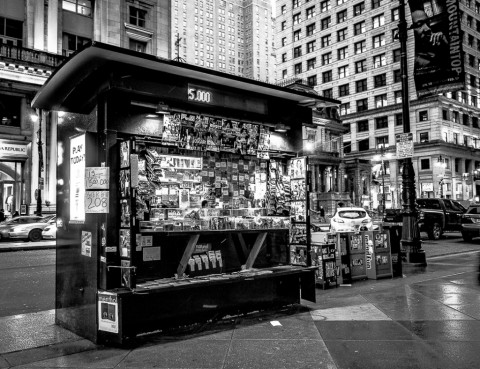So, the retailing waters have been tested at one day shows and you’ve enjoyed the experience and see opening a comic book store as a viable option, but now it’s time to find a location and determine what kind of comic shop you want.
Being a comic book fan you either already shop at a comic store or have no store within a reasonable distance. If you’re in a major metropolitan area look for an underserviced area of town with breathing room between you and any existing shops. If no stores are nearby look at whether that area can sustain a comic shop; easy to get to, lots of parking, etc. Areas around colleges and universities work well, but rental and operating costs need to be factored in.
Your store vision is very important, and will drive the rest of your choices. Do you want a sleek wooden design with subdued lighting, a bright and cheerful layout with lots of colour, or something in between? Will your focus be superheroes, monthly comics, hardcovers and trade paperbacks, back issues, children’s comics, or a mix of everything?
Your personal collection is the base of your inventory, but it’s only a starting point. Now maybe you don’t want to carry too many superhero books. That is fine, but even if you specialize in small press or indy books your personal collection probably won’t appeal to a broad enough customer base that you can forego buying new product. And new product is key. Like we said above, a personal collection can help you fill out your store but in general people want to see that new set of books every Wednesday. And for that you need a Diamond account.
Diamond Comics Distributors is the company responsible for distributing comic books to stores in North America; they (basically) have a monopoly so it’s the only game in town. You’ll want to set yourself up with an account; the process is relatively straight forward, and standard for any distributor. Complete a credit application and wait for approval. Diamond also offers COD and credit card payment (with a 3% penalty for processing fees), which is a short term option but not recommended.
How much initial product you’ll need to order will be based on the size of your store, but for most spaces it will probably be $10,000 to $30,000 worth of product. You probably don’t know what your customers will like yet, so you’ll want to stick to a wide range of product. And it isn’t just comic books anymore. Maybe you’ll want to be a purist and only stock comic books in your store. That is fine, but without diversifying into t-shirts, toys, and games you may find it difficult to appeal to a wide customer base. Like it or not, different types of product are now expected of a comic book store.
So you’ll probably need to order a good range of new comic books. But how many copies of each? This will be the tricky part because you can’t really do anything more than make guesses. There is no magic formula, and no secret way to know how many copies of something will sell even if you have years of data. Unfortunately you are coming at this cold. So our advice is to start with what you can afford. Early on you it is better for you to sell out of something than to have a glut of product that you can’t move. You can adjust later or try for reorders.
You’ll also want to order a good range of trade paperbacks that are both new and hot, plus evergreen favourites. We’d recommended Batman: Year One, Walking Dead, Saga, Dark Knight Returns, and Watchmen. Doing research into which trade paperbacks consistently sell in the top ten will help you determine some safer bets that will appeal to (hopefully) every customer base.
After you’ve decided on what to order for new comic books and trade paperbacks we would suggest you fill out the rest of the store with product that might be unique to your vision for your shop. Do you want to have a large board games section? Or specialize in RPGs? Apparel? Toys? You can go a bit deeper on whatever you think your specialized knowledge will help you sell. This is the part of the store where you should be honest and stick with what you know. Just remember that you need to admit that customers like a wider range of product than you do.
As an example: maybe you love board games. You have a bunch at home and they all deal with zombies in some way. That’s great! Zombies are fun. But board game fans like more than just zombie board games and you’ll be doing yourself a disservice if you don’t stock Settlers Of Catan and Ticket to Ride. Again start small with your inventory, stocking one of bigger ticket items.
There is no magic formula to creating the perfect inventory for a new store, but with research, ordering perennial favourites, and using your own collection you will have a solid base to provide customers with a wide range of comic book product.

